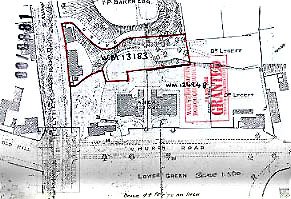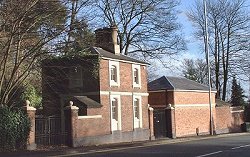| Avenue House Lodge was built c1840 as the gate
house and the stabling accommodation for the owners of and
visitors to the Avenue House in Clifton Road Tettenhall. It is
situated at the bottom of the Rock (A41), before it cuts through
the sandstone rock to Upper Green. The Lodge would have been the
first point of entry. Access to the main house was gained
via the graveled driveway around the rear of the house. |
 |
Avenue House Lodge's plot of
land is highlighted in red. The Rock (A41) runs from top
to bottom of the plan and Old Hill and Church Road run across
the plan just below the Lodge. |
The Lodge House can be briefly described
externally as:
| Brick built with stucco dressings;
hipped slate tiled roof with three stack chimneys. A two story
building with a two-window range. Built on a blue brick plinth, with
an ashlar platt band over the ground floor. Ground floor windows are
9 panel box-sash over recessed apron panels; first floor has 6 panel
box-sash. The front entrance is through the wrought iron gates that
lie at the foot of the rear driveway to the main house. The front
entrance has a six-panel, French style door and has a gable roof
above.
|
| The Lodge, and its
outbuildings, as they now are, seen from the Rock. |
 |
The house as originally built was a very
'grand' looking two-up two-down. The house was a simply dwelling for the
gate keeper/groom to the owner of the main house. The house originally
consisted of a main living room, with a cast iron fire place with oven
and hobs. Access to the parlour was via the main living room. Access to
the original staircase was also via the main living room. The
stairs would have been incredibly steep and would have given access to a
small landing area. From there two doors would have given access to the
main bedroom with open fire and to the second small children's room
(with no heating!). The lavatory was at the bottom of the courtyard at
the back of the coach store building. There was also a pig sty and
rubbish heap. The outbuildings consisted of a stable block with hay loft
above and a separate coach carriage storage building, linked via
internal doors. Access to them was gained via the main board gates off
the main road or via a link path from the rear driveway.
In 1998 I purchased the property and
embarked on a sympathetic renovation. On the next page are a few
picture illustrating the changes to Avenue House Lodge since 1998 to
present.
|

